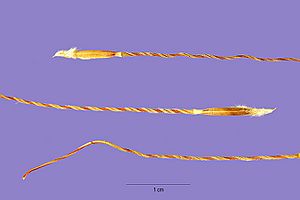Texas wintergrass facts for kids
Quick facts for kids Texas wintergrass |
|
|---|---|
 |
|
| Fruits showing the long awns | |
| Conservation status | |
| Scientific classification | |
| Genus: |
Nassella
|
| Species: |
leucotricha
|
| Synonyms | |
|
|
Nassella leucotricha is a type of grass often called Texas wintergrass. You might also hear it called Texas needlegrass or Texas tussockgrass. This grass grows naturally in the south-central United States, including states like Texas, Oklahoma, Arkansas, Louisiana, and Mississippi. It also grows across a large part of Mexico, from Tamaulipas down to Chiapas.
Contents
About Texas Wintergrass
Texas wintergrass is a perennial bunchgrass. This means it lives for more than two years and grows in clumps or bunches. Its stems can grow quite tall, up to about 1.2 meters (nearly 4 feet) high.
How Texas Wintergrass Reproduces
This grass has two kinds of flowers. Some flowers open up and are pollinated in the usual way. Other flowers are called cleistogamous. These flowers do not open. Instead, they pollinate themselves. Sometimes, these self-pollinating flowers are hidden inside the leaf sheaths of the plant.
The Grass Seed and Its Impact
The fruit of the Texas wintergrass has a very sharp tip. It also has a long, twisted part called an awn, which can be up to 9 centimeters (about 3.6 inches) long. This sharp fruit can sometimes get stuck in the mouths of farm animals. It can also get tangled in their wool or irritate their eyes.
Texas Wintergrass as Food for Animals
When Texas wintergrass is green, it is good food for animals like cattle. However, farmers need to be careful. When the seeds start to grow on the plants, animals should be moved away from the area. This is because of the sharp seeds. Once the seeds have fallen to the ground, the animals can safely return to graze.
Is Texas Wintergrass a Weed?
While Texas wintergrass is a native plant in its home region, it can become a problem in other places. For example, in Australia, it is considered an invasive species. This means it grows where it is not wanted and can cause harm. In Australia, it can be harmful to livestock because of its sharp seeds.


